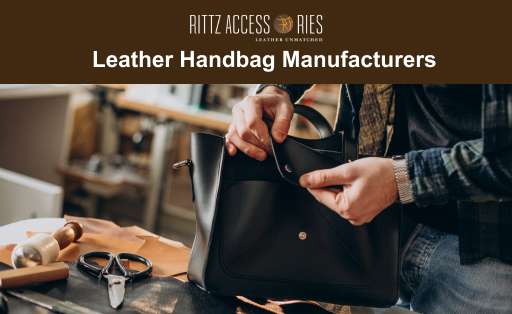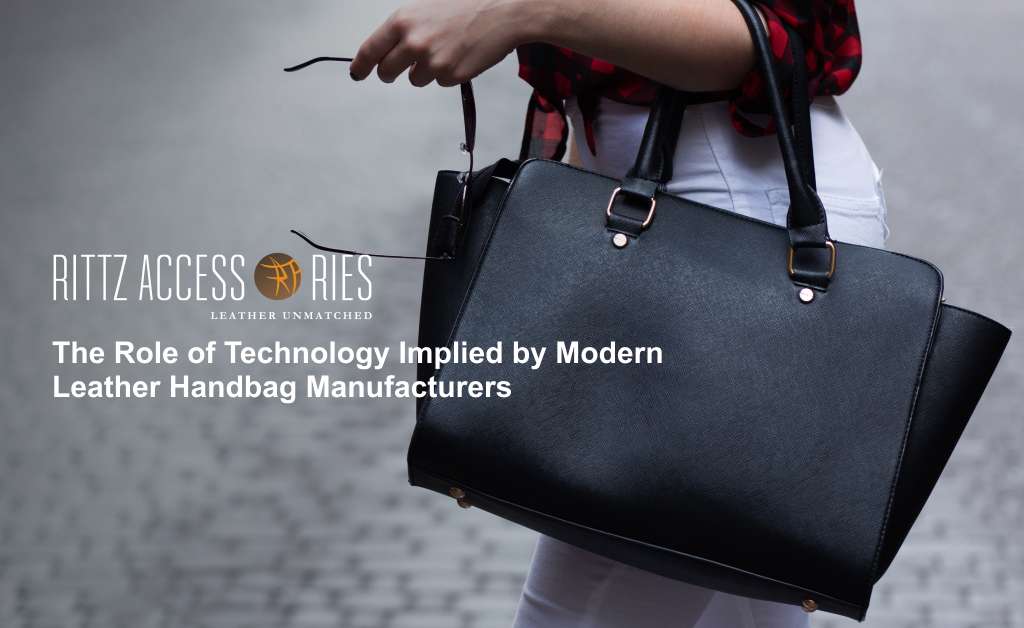Introduction
Leather handbags continue to captivate people in the ever-changing world of fashion. However, the substantial role that technology plays in practically every stage of production sets current leather handbag producers apart from their forebears. Technology has emerged as a quiet collaborator, subtly altering the industry while the creativity and skill of leatherworking remain at its core.
Rittz Accessories will examine the role of technology implied by modern Leather Handbag Manufacturers in both implicit and explicit ways, covering design, production, sustainability and user experience.
Using the Digital Canvas for Design and Prototyping
In the field of contemporary leather handbag design, technology is both pervasive and transformational. The use of technology throughout the design and prototyping stages has not only sped up the creative process but also broadened the possibilities for the beauty and usefulness of leather handbags.
- CAD, or computer-aided design
The use of CAD software has become a need for modern leather handbag makers. It provides a digital canvas on which designers can experiment with different designs, make complicated patterns, and precisely adjust little features. The time needed to complete a design is decreased by the ease with which CAD modifications and adjustments can be made as opposed to conventional hand-drawn sketches. Designers may work with a wide range of colors, textures, and shapes while yet keeping a high standard of accuracy and consistency.
- 3D printing
The prototyping stage of the production of leather handbags has undergone a revolutionary change because of 3D printing technology. Designers may now quickly translate their computer blueprints into physical prototypes. This quick prototyping capabilities shortens the time to market and speeds up the product development cycle.
It makes it possible to design complex hardware parts and closures with a level of precision that was previously unachievable. Additionally, because only the necessary amount of material is used for each prototype, 3D printing saves material waste. This effectiveness fits with the industry’s growing emphasis on sustainability, where reducing waste is a key objective.
Additionally, during the prototyping stage, designers can experiment with different materials to see how various fabrics, leather types, and hardware components work together. Through experimentation, the final design is improved for both use and beauty.
Effective and Transparent Materials and Sourcing
- Cutting Leather Automatically
Automated Leather Cutting Laser cutters are now essential tools in the production of leather handbags. There is little material waste as a result of the unmatched precision these machines provide when cutting leather pieces. Precision cutting ensures that the pieces will fit together without any gaps during installation.
Additionally, complicated patterns and sophisticated designs can be handled using automated leather cutting equipment. With this skill, designers can exercise their creativity without sacrificing accuracy. Laser cutting machines can easily implement these designs, whether they are complex flower patterns or geometric shapes.
- Supply Chain Administration
Throughout the supply chain, RFID (Radio-Frequency Identification) technology is essential for monitoring and tracking materials. RFID chips that provide real-time information on an object’s position and condition can be attached to any material object, from leather hides to hardware parts. In order to avoid delays and shortages, this gives manufacturers total visibility over the movement of commodities.
Technology improvements have also made sustainable production and ethical sourcing more feasible. For instance, transparent supply chain networks that confirm material sourcing and guarantee adherence to moral and environmental norms can be built using blockchain technology. This helps manufacturers as well as satisfies rising customer demand for sustainable and ethically sourced goods.
Precision and Efficiency in Manufacturing and Production
- Automation and Robotics
Automation and robotics integration have revolutionized the production of leather handbags. Today, robotic arms are used for a variety of production tasks, including stitching, assembling, and quality checking.
Robotic arms excel in performing routine chores with amazing accuracy and speed. They can consistently install hardware, sew seams, and carry out other assembly activities without getting tired or making mistakes. Each handbag is manufactured with such accuracy that it satisfies the highest requirements for quality.
It’s important to note that the incorporation of robotics enhances rather than replaces human workmanship. Expert craftspeople supervise the manufacturing process alongside robots, giving the finished product the crucial human touch.
- Quality Assurance
In the leather handbag industry, quality control is crucial, and technology has elevated this concept to new levels. Artificial Intelligence algorithms-driven machine vision systems closely examine each handbag’s component parts.
These algorithms can spot faults in the leather, such as uneven stitching, misaligned seams, or flaws that could be invisible to the human eye. As a result, there are much fewer rejected products, which raises overall quality.
Additionally, machine vision systems put out a lot of effort to guarantee that each handbag satisfies the defined quality criteria. They are infallible in terms of consistency and objectivity since they are not susceptible to drowsiness or changes in judgment that might happen with human inspectors.
Personalization & Customization: Giving the Consumer Power
- Online Try-On
Virtual try-on experiences not only improve the online shopping experience but also lessen the risk involved in buying expensive things online. Customers’ confidence in their buying decisions grows as they have a better understanding of how a specific handbag will fit into their outfit.
These augmented reality (AR) applications use the camera on smartphones to overlay digital images of handbags over the physical environment. Customers may see how various handbags combine with their personal style, think about available colors, and even judge the size and fit in relation to their clothing.
This technology implied by Leather Handbag Manufacturers has the potential to increase customer interaction and lower return rates, which would ultimately be advantageous for both customers and producers.

- Recommendations Powered by AI
AI algorithms have gotten good at examining consumer information and preferences to recommend customized handbag designs. These algorithms can suggest products to clients who are browsing a brand’s website or online store that match their preferences.
The suggestions are based on variables like previous purchasing patterns, browsing habits, and demographic data. For instance, the AI system may spot trends and recommend products that are comparable to leather handbags if a customer frequently chooses those with specific features or fashions.
The effectiveness of AI-driven recommendations resides in their capacity to boost client loyalty and promote recurrent purchases. Customers are more inclined to return for subsequent purchases when they believe that a company understands their preferences and caters to their specific desires.
Environmental Impact and Sustainability: Towards a Responsible Future
- Alternatives to Sustainable Materials
The investigation of substitute materials for conventional leather has been prompted by the desire for sustainable and environmentally friendly products. Technology plays a crucial role in the creation and use of these sustainable materials.
For instance, some producers are experimenting with plant-based materials like leather alternatives made from mushrooms that have a smaller environmental impact than conventional leather. These substitutes are frequently created using sophisticated biotechnological techniques.
Technology is driving innovation in the manufacture of sustainable materials, from effective cultivation techniques to lowering water and energy use throughout production. Industry leaders now prioritize meeting consumer demands for ethically sourced and environmentally conscientious goods, and technology is enabling producers to take important steps in this direction.
- Energy Savings
Modern factories have adopted energy-saving technologies to cut down on their carbon footprint and operating expenses. These innovations not only benefit the environment but also the user’s wallet.
A smaller carbon footprint is facilitated by machinery, HVAC systems, and lighting that are energy-efficient. In addition, businesses in the manufacturing industry are increasingly powered by sustainable energy sources including solar and wind energy. For instance, these systems can reduce energy waste by adjusting lighting and temperature settings based on occupancy or production needs.
Energy-saving solutions are being adopted in line with the general industry trend towards sustainability and ethical manufacturing procedures. It demonstrates a dedication to enhancing operational effectiveness while simultaneously lowering the environmental impact of leather handbag manufacture.
Conclusion
By implying modern technology, Leather Handbag Manufacturers have permanently changed every step of the procedure. Technology plays an implicit but essential part in everything from design innovation to improved material procurement, efficient manufacturing, personalized customer experiences, and sustainability initiatives.
Finding a good balance between efficiency and ethics, as well as between technology and tradition, will be crucial as the sector develops further. The modern leather handbag is a representation of timelessly beautiful craftsmanship that has been enhanced by technology, which ushers it into the future with both style and substance.

